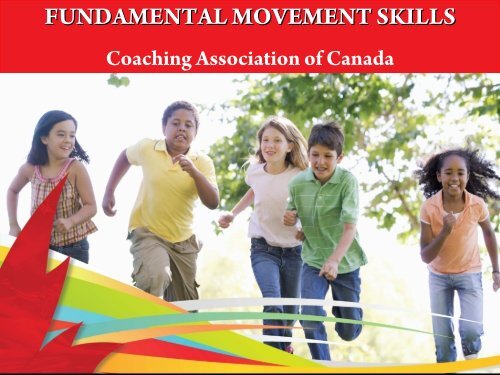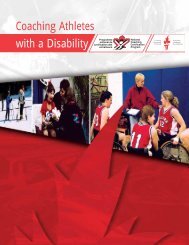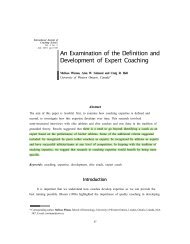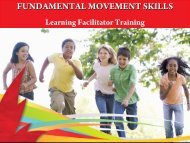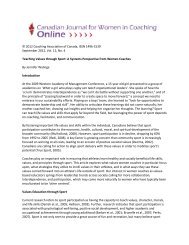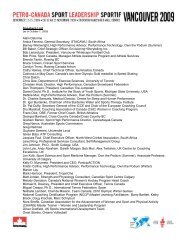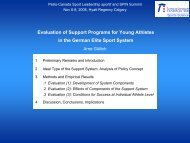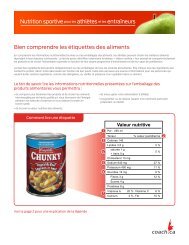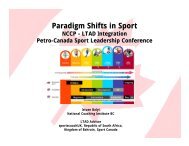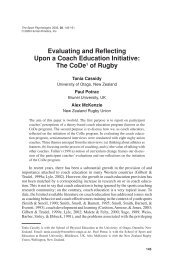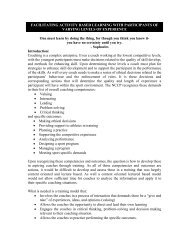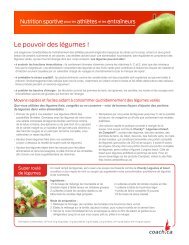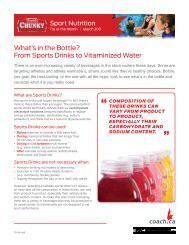Fundamental Movement Skills - Coaching Association of Canada
Fundamental Movement Skills - Coaching Association of Canada
Fundamental Movement Skills - Coaching Association of Canada
You also want an ePaper? Increase the reach of your titles
YUMPU automatically turns print PDFs into web optimized ePapers that Google loves.
FUNDAMENTAL MOVEMENT SKILLS<br />
<strong>Coaching</strong> <strong>Association</strong> <strong>of</strong> <strong>Canada</strong>
Canadian Sport for Life (LTAD)
•<br />
•<br />
•<br />
•<br />
Outcomes<br />
Create safe games where children can practise<br />
fundamental movement skills<br />
Apply a six‐step teaching process to fundamental<br />
movement skills<br />
Model responsible behaviour in a leadership role<br />
Lead children in activities that will promote the<br />
development <strong>of</strong> fundamental movement skills
•<br />
•<br />
NCCP Core Competencies<br />
The NCCP’s five core competencies will help you become a more<br />
effective leader and have a more meaningful impact on learners’<br />
experience<br />
The five competencies are:<br />
»<br />
»<br />
»<br />
»<br />
Problem‐solving<br />
Valuing<br />
Critical Thinking<br />
Leading<br />
» Interacting
•<br />
Unit 1: Summary<br />
The competencies <strong>of</strong> the NCCP are:<br />
» Problem‐solving<br />
» Valuing<br />
» Critical Thinking<br />
» Leading<br />
» Interacting
•<br />
•<br />
•<br />
Unit 2: Learning to Teach<br />
<strong>Movement</strong> <strong>Skills</strong><br />
Where to observe different movement skills from<br />
The four phases <strong>of</strong> movement<br />
Characteristics <strong>of</strong> effective feedback
Where to Observe From Worksheet
Where to Observe From Worksheet
Phases <strong>of</strong> <strong>Movement</strong><br />
Four Phases<br />
1. Preparation<br />
2. Force production<br />
3. Critical instant<br />
4. Recovery/Follow‐through<br />
Key Ideas<br />
• Use all the body parts (joints) that can be used<br />
• Use them through as great a range <strong>of</strong> motion as is naturally<br />
possible<br />
• Critical instant is the moment <strong>of</strong> release<br />
• Follow through in the direction you want the “force” to go
Phases <strong>of</strong> <strong>Movement</strong> Examples
F<br />
P P<br />
F<br />
F C C<br />
FR<br />
F<br />
P<br />
F
•<br />
•<br />
•<br />
•<br />
Communicating What to Do<br />
to Improve<br />
Get eye‐to‐eye with participants<br />
Be positive, tell them something they did right<br />
Listen to what they tell you<br />
Body language says more than words
•<br />
•<br />
•<br />
•<br />
Start positive<br />
Effective Feedback<br />
Keep it short and simple<br />
Tell people what you WANT THEM TO DO —not<br />
what they did wrong<br />
Make sure people understand what you want them<br />
to DO
•<br />
•<br />
•<br />
•<br />
•<br />
Unit 2: Summary<br />
Moving to a suitable position to view a skill<br />
Demonstrating correct observation positioning<br />
Identifying: Preparation, Force production, Critical instant,<br />
Follow‐through/Recovery<br />
Communicating effectively<br />
Providing feedback to improve skill performance
•<br />
•<br />
•<br />
•<br />
•<br />
•<br />
Unit 3: Throwing<br />
Children go through stages in learning to throw<br />
Young children cannot throw with an adult throwing pattern<br />
Three stages <strong>of</strong> maturity for throwing<br />
Key factors that contribute to having a mature throw<br />
Six‐step teaching model<br />
How to organize games to practise skills
1.<br />
2.<br />
3.<br />
4.<br />
5.<br />
6.<br />
Instructional Design Model<br />
Identify<br />
Coaches analyze<br />
the coaching challenge<br />
Coaches generate<br />
Coaches plan<br />
Implement<br />
Assess<br />
the coaching challenge<br />
ideas and options<br />
and develop solutions<br />
and/or test the solution<br />
the solution
Stage 3<br />
Stage 1<br />
Stage 2
•<br />
•<br />
•<br />
Six‐step teaching model<br />
Unit 3: Summary<br />
Children go through stages in learning to throw and<br />
cannot throw with an adult throwing pattern<br />
Three stages <strong>of</strong> maturity for throwing
•<br />
•<br />
Unit 4: Creating Safe Fun Games<br />
How to organize games to practise skills<br />
Creating safe games where children can practise their<br />
skills
Games<br />
Fun<br />
Safe<br />
Simple<br />
Everyone participates –avoid elimination<br />
Graduated challenges<br />
A chance to practise skills
Locomotor<br />
•<br />
Disability<br />
Adaptations<br />
The inability to move oneself and objects from place to place.<br />
Sensory Disability<br />
•<br />
A disability that affects how people gather information from the world<br />
around them.<br />
Intellectual Disability<br />
•<br />
Any condition that includes a lifelong impairment <strong>of</strong> a person’s ability to<br />
learn or adapt to his or her environment.
•<br />
•<br />
•<br />
Unit 4: Summary<br />
Creating and organizing games to practise<br />
skills<br />
Adapting games for a person with a disability<br />
Keeping activities safe
•<br />
•<br />
•<br />
•<br />
Unit 5: More <strong>Fundamental</strong><br />
<strong>Movement</strong> <strong>Skills</strong><br />
Children go through stages in learning to run, jump, kick,<br />
strike, and catch and young children cannot run, jump, kick,<br />
strike, or catch with an adult pattern<br />
Choosing the optimal position to observe running, jumping,<br />
kicking, striking, and catching<br />
Applying the six‐step teaching model to running, jumping,<br />
kicking, striking, and catching<br />
Creating and adapting games to practise skills
More <strong>Fundamental</strong> <strong>Movement</strong> <strong>Skills</strong><br />
Preparation<br />
Force Production<br />
Critical Instant<br />
Follow‐through<br />
Stage 1 Stage 2 Stage 3
•<br />
•<br />
•<br />
Unit 5: Summary<br />
How to identify different stages <strong>of</strong> running, jumping, kicking,<br />
striking, and catching<br />
There are key factors that contribute to developing a mature<br />
run, jump, kick, strike, and catch<br />
Applying the six‐step teaching model to running, jumping,<br />
kicking, striking, and catching
Unit 6: Summary<br />
•The NCCP is <strong>Canada</strong>'s National <strong>Coaching</strong> Certification<br />
Program<br />
•After completing this workshop, participants will be<br />
entered in the NCCP Database as having completed the<br />
NCCP <strong>Fundamental</strong> <strong>Movement</strong> <strong>Skills</strong> Coach<br />
Pr<strong>of</strong>essional Development Workshop<br />
•The processes learned in this module can be applied to<br />
the analysis and improvement <strong>of</strong> fundamental<br />
movement skills AND sport‐specific skills


